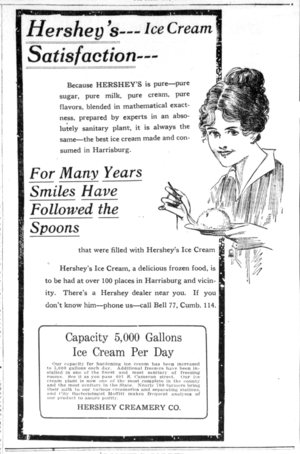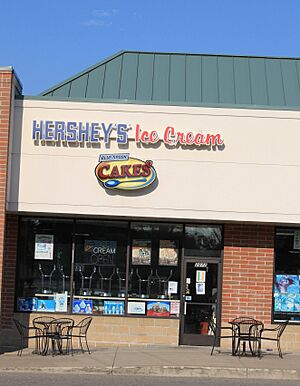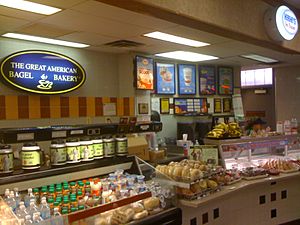Hershey Creamery Company facts for kids
 |
|
| Public | |
| Traded as | Expert Market: HRCR |
| Industry | Ice cream manufacturer |
| Founded | 1894 in Lancaster, Pennsylvania U.S. |
| Founders | Jacob Hershey Isaac Hershey John Hershey Paris Hershey Eli Hershey |
| Headquarters |
,
U.S.
|
|
Area served
|
Northeastern and Eastern United States |
|
Key people
|
George Holder, president Walter Holder, vice president of manufacturing Tom Holder, vice president of sales and marketing Robert Campbell, controller |
| Products | Ice cream, sherbet, ice cream cake, frozen slab, smoothies |
|
Number of employees
|
450 |
Hershey Creamery Company, also known as Hershey's Ice Cream, is an American company that makes delicious frozen treats. They produce ice cream, sorbet, sherbet, frozen yogurt, and other cool desserts. These include smoothies and special frozen slab ice cream mixers.
The company was started by Jacob Hershey and his four brothers in 1894. Later, in the 1920s, the Holder family took over the business. Hershey Creamery was one of the first companies to sell ice cream in handy pre-packaged pints.
Today, this family-owned business has about 450 employees. They have 30 distribution centers in 28 states across the Eastern and Northeastern United States. The company's shares are traded on a special market called Pink Sheets. This means they offer a limited number of shares to people who want to own a small part of the company. In 1998, the company updated its operations to work more efficiently.
It's important to know that Hershey Creamery Company is not connected to The Hershey Company, which makes chocolate. Both companies started in Lancaster County, Pennsylvania in the same year. They have had some disagreements over the years about using the "Hershey's" name. In the mid-1990s, they agreed that Hershey Creamery would add a note to its ice cream products. This note explains that they are not linked to the chocolate company.
Contents
The Story of Hershey's Ice Cream
The Hershey Creamery Company began in 1894. It was founded by five brothers: Jacob, Isaac, John, Paris, and Eli Hershey. They started making ice cream right from their family farmhouse in Lancaster County, Pennsylvania.
The brothers designed and built special wooden containers lined with metal. These containers were filled with ice to keep the ice cream cold and fresh. Salesmen would travel daily routes in trucks. They delivered the tasty ice cream to customers in their county and nearby areas.
In 1920, the company bought Marrow's Ice Cream in Lancaster. Marrow's had a big facility and made a lot of ice cream each day. Later in the 1920s, Hershey Creamery joined with the Holder family's Meyer Dairy Company. They decided to keep the Hershey name.
By 1926, more and more people wanted their ice cream. The farmhouse was too small, so the company built its first ice cream plant in Harrisburg, Pennsylvania. During the Great Depression, Hershey Creamery was the first ice cream maker to sell its products in pre-packaged pints. They also started creating new ice cream flavors.
After World War II, people wanted more convenient foods. The company began offering single-serve treats like ice pops and ice cream sandwiches. In the 1960s, the Holder family became the full owners of the company.
As the company grew, it split its production. The Harrisburg location mixed the ice cream. A new facility in Lower Swatara Township was used for hardening and packaging. Local orders were delivered by small refrigerated trucks. For longer distances, they used large refrigerated tractor trailer trucks. This helped them sell ice cream beyond Pennsylvania.
The company also expanded its distribution centers. This meant products could be shipped faster and stay fresh. In the summer, they hired more workers and rented extra cold storage. This helped them meet the high demand. In 1998, they built a huge, modern warehouse in Middletown. This made their operations much more efficient. It also helped them manage their inventory better and reduce waste.
Name Differences with The Hershey Company
Hershey Creamery has had several legal disagreements with The Hershey Company. The chocolate company was founded around the same time by Milton S. Hershey. Even though they share a name and started in the same area, Milton Hershey was not related to the Hershey brothers who founded the ice cream company.
The first issues came up when Hershey Creamery started making chocolate candy. In 1926, a judge ruled that the creamery could not use the "Hershey's" name for chocolate products.
In 1958, the creamery got the "Hershey's" trademark for ice cream and butter. Later, in 1965, they sued Hershey Company. This was because the chocolate company planned to make Hershey's branded ice cream bars. The companies settled out of court in 1966. The creamery agreed to drop "butter" from its trademark. The chocolate company agreed not to challenge the creamery's ice cream trademark again.

After this, Hershey Creamery expanded its trademark to include other frozen treats. In 1989, they started making frozen yogurt. The Hershey Company (then called Hershey Foods) asked them to stop. After more legal discussions, the two companies settled again in the mid-1990s. Hershey Creamery agreed to put a note on all its products and website. This note says they are "not affiliated with Hershey's Chocolate."
Following Safety Rules
In 2008, Hershey Creamery Company was involved in a case about following environmental safety rules. The Environmental Protection Agency (EPA) found that the company had not fully developed a required plan. This plan was for safely storing and using a substance called anhydrous ammonia.
The company quickly worked to fix this. They submitted the correct plans in 2007. Hershey Creamery admitted to the issue and paid a fine. They also agreed to a period of probation to ensure all rules were followed.
How Hershey's Ice Cream Works
Hershey Creamery is a family-run business. New generations of the Holder family often take on roles in the company after finishing school. As of 2009, George Holder was the president. His younger brothers, Walter and Tom, were vice presidents for manufacturing and sales. The company has about 450 employees.
The company has 22 distribution centers. These centers serve about 22,000 clients in 28 states across the eastern United States. Since 1996, the company has focused on its main distribution center. They also plan to move their headquarters and production facilities to the Lower Swatara area.
Unlike some other ice cream makers, Hershey Creamery owns its delivery trucks, distribution centers, and warehouses. The Holder family believes this helps them keep their company traditions strong.
Most of their sales come from ice cream parlors and quick-serve restaurants. They also sell pre-packaged items to convenience stores and food service places. These include schools, hospitals, and sports stadiums. Pre-packaged items are also sold in some supermarkets, but this is a smaller part of their business.
Company Finances
Hershey Creamery Company is a publicly traded company. This means people can buy shares of the company. However, only a limited number of shares are available. Most of these shares are owned by the Holder family. The company provides reports to its shareholders every year.
In 2001, the company reported sales of $91.4 million. This resulted in a profit of $4.6 million. The company has been recognized in Dairy Foods magazine's list of top dairy companies.
What Hershey's Ice Cream Makes
As of 2009, Hershey Creamery Company offered 108 flavors of regular, hand-dipped premium ice cream. Some of these were "super premium" flavors. They also had some "no sugar added" options.
They also offered two flavors of sorbet, three flavors of sherbet, and eight flavors of frozen yogurt. For pre-packaged half-gallons, they had 32 ice cream flavors, including some no-fat options. They also offered pre-made ice cream cakes.
Besides traditional ice cream, Hershey Creamery makes many fun novelty treats. These include ice cream sandwiches, Ice pops, sundae cups, and pre-made cones. They also sell smoothies under their "Tropi-Kool Smoothies" brand. Their "Creation Station" brand offers frozen slab ice cream.
They once tried an "Energy Ice" product, which was a frozen energy drink. It had a citrus flavor and came in a squeeze-up container. However, this product was not a financial success and was later stopped.
See also
- List of dairy product companies in the United States




